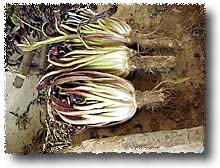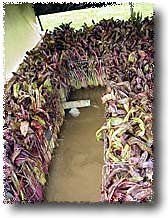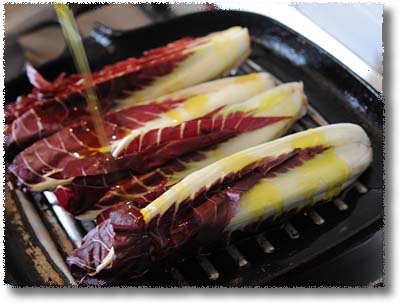
Radicchio Di Treviso Tardivo

Radicchio, Picked from the Ground
Radicchio has a long history: Pliny mentions the marvelous red-lined lettuces of the Veneto region in his Naturalis Historia,noting that in addition to being tasty they’re good for insomnia and purifying the blood; he also says it was the Egyptians who bred radicchio from its more wild ancestor, chicory. In the Middle Ages it was especially popular among monks, who welcomed anything that would perk up the simple, predominately vegetarian diets proscribed by their orders.

Radicchio On The Way To The Shed
Not that the plant was limited to monastic kitchens; it also figured prominently on the tables of nobles, both cooked and raw: In 1537 Pietro Aretino advised a friend who had a garden to plant it, saying he much preferred it to “aroma-free lettuce and endive.”
While tasty, Pliny’s radicchio isn’t the radicchio rosso we know today. The modern radicchio with its rich wine-red white-ribbed leaves was developed in the 1860s by Francesco Van Den Borre, a Belgian agronomist who applied the techniques used to whiten Belgian endive to the radicchio grown around Treviso. The process,

Radicchio: Imbianchimento
which is called imbianchimento, is quite involved: the plants are harvested in late fall, their outer leaves are timmed and discarded, they’re packed into wire mesh baskets, and they’re stood for several days in darkened sheds with their roots bathed in steadily circulating springwater that emerges from the ground at a temperature of about 15 C (60F). As they bathe the leaves of the hearts of the radicchio plants take on the pronounced wine-red color that distinguishes them (the deeper the red the more pleasingly bitter the plant). At this point the farmer unties the bunches, strips away the outer leaves, trims the root (the tender part that’s just below ground level is tasty), and sends the radicchio to the market.
If you visit a well-stocked Italian market you will find a number of different kinds of Radicchio Rosso. The most important are:
Radicchio Rosso di Treviso.The best, it comes in two varieties: Precoce,

Radicchio di Treviso Precoce
which has fleshy red leaves with white ribs that form a compact bunch, and Tardivo (see above), which has much more pronounced ribs and the splayed leaves. As you might guess, precoce comes into season first, and though it is prettier to look at the tardivo is more flavorful, with stronger bitter accents. Both Precoce and Tardivo now enjoy IGP (Indicazione Geografica Protetta) status, which means that they can only be sold as such if they are produced around Treviso, under the supervision of the Consorzio Radicchio di Treviso.

Radicchio Variegato Dic Cstelfranco
Radicchio Variegato di Castelfranco also enjoys IGP status; it looks more like a traditional head of lettuce but has deep wine-red stripes, and is also known as the Edible Flower. It’s a cross between radicchio and a round-headed endive.

Radicchio Di Chioggia
Radicchio Rosso di Chioggia was bred from the Variegato; it has dark red leaves with white ribs, but is rounder than Radicchio di Treviso; it’s also compact, and as a result it resembles a head of cabbage in shape. It’s now the most commonly grown radicchio rosso in Italy, and is (alas) sold as radicchio di Treviso in other parts of Europe. I’ve also seen it in seed catalogs in the US.
Radicchio Rosso di Verona was bred from Rosso di Treviso in the 50s, and is somewhat fuller shaped than its ancestor.
Radicchio, like almost everything else in Italy, is quite seasonal, appearing in the markets in late November and remaining throughout the winter. It’s tastiest after the frosts begin, and is therefore worth waiting on if the winter is mild. It has also been introduced to California’s Napa Valley and is becoming popular in the US too. Small wonder; it’s quite good. And also good for you; Radicchio’s bitterness is due to intybin, which stimulates the appetite and digestive system, and acts as a tonic for the blood and liver.
Now that you’ve bought some radicchio, what to do with it?
When you get it home put it in the crisper section of your refrigerator. It will keep for a couple of days, and if it looks slightly wilted stand it in a glass of water — the tap root isn’t just there for show; it also has nutrients that feed the leaves and can absorb water. When you trim the root prior to using the radicchio, don’t discard it, but rather use it as you would a radish or other root vegetable.
My thanks to the kind folks at the Consorzio Radicchio di Treviso IGP and Treviso’s Consorzio di Promozione Turistica for organizing a delightful weekend in Castelfranco Veneto, during which I learned much and took photos. If you are in the area, don’t forget to check the Strada del Radicchio, which includes itineraries dedicated to discovering Radicchio Trevigiano, and much more.
And Finally, Some Recipes
How to Grill Radicchio, Illustrated
How to Grill Radicchio, without the photos











